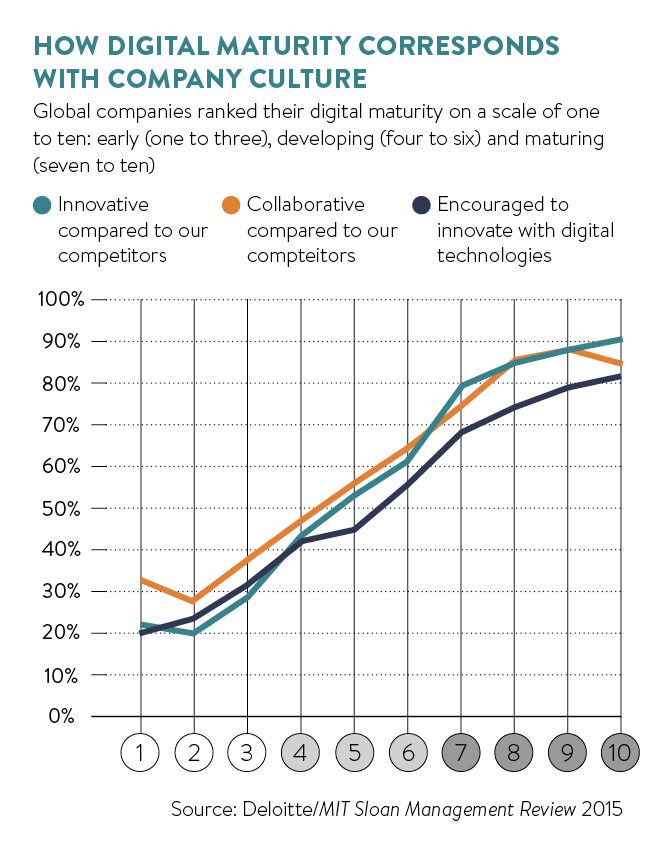Culture eats strategy for breakfast. While this may be something of an overused cliché, when it comes to digital transformation, nothing is closer to the truth.
If you’re looking to re-orient your organisation for success in our constantly evolving digital world, chances are you’re not a new tech startup. It’s more likely you’re an established organisation that’s recognised the need to be different.
And with established organisations comes legacy business models, enshrined processes and ways of working, and a culture – whether implicitly or explicitly defined – that supports how you operate.
Culture isn’t something you change by decree, but by changing the prevailing conditions within the organisation that will, over time, lead to a culture evolving
The trouble is transformation means change – usually lots of it. And that means culture – the sum of the values, behaviours and “norms” of those in your organisation – which supports you today may end up inhibiting you tomorrow.
Changing environment
Any successful digital transformation requires a coherent vision, articulated in a way that gives meaning to all employees and rallies them around the upside potential of the change envisioned.
But what good is a vision and eloquent storytelling if, when your workforce returns to their desks, they’re confronted by processes, behaviours and ways of working that get in the way of the proposed change, rather than enable it? These are the same processes, behaviours and ways of working that support today’s system and status quo, rather than the organisation you’re trying to create for tomorrow?
It’s not enough for leaders to set the vision. If they don’t create the environment for it to thrive, your workforce won’t adapt. That means missed opportunity, wasted effort and a disengaged workforce. This is where culture truly comes into play. And culture isn’t something you change by decree, but by changing the prevailing conditions within the organisation that will, over time, lead to a culture evolving.
A number of imperatives have emerged for those hoping to influence cultural change in support of a digital transformation initiative.
Bureaucracy: the real-time nature of digital initiatives means organisations are empowered to make changes after minutes and hours, not days or weeks. Typically, however, established organisations suffer from layers of approval processes and sign-off requirements that fly in the face of the opportunity to pivot based on real-time intelligence. Leaders need to challenge “decision rights” and empower those with the insight to take choices in the here and now, not in three weeks after submitting a report and escalating an issue or opportunity through ranks of inefficient bureaucracy.

Iteration: traditional software development has favoured waterfall development, where teams work tirelessly to get a product or service to a point of perfection before release. In today’s world of rapid prototyping and immediate feedback, it’s often better to release something quickly with a test-and-learn mentality. You can then garner immediate feedback to help iterate, rather than spend months in development and testing only to find yourself outplayed by a competitor or dealing with failure after a much more resource and time-intensive development timeline.
Agility: established organisations are accustomed to monthly and quarterly performance review cycles, yet this creates a time-lag which undermines the immediacy of digital activity. When something works well or underperforms, the notion of waiting for the next monthly committee meeting to analyse performance is anathema to a digital workforce.
Collaboration: digital doesn’t respect functions, silos or organisational hierarchy. It permeates an organisation and demands that people in different teams, often with different priorities, work together to make progress. Regrettably, many organisations suffer from politics and fiefdoms which make this challenging to accomplish in practice. Leaders must identify these blockages and break them down to avoid limiting the potential of digital transformation.
Shared ownership: re-orienting an organisation to our digital world often brings tough choices. Cannibalisation, trade-offs and conflicts around key performance indicators (KPIs) are all too common, but can be overcome by translating an organisation’s digital imperatives into shared objectives and KPIs across leaders and functions. Digital transformation shouldn’t be the preserve of a digital director or department; if it’s truly an organisational priority, this has to be reflected in how all leaders and functions are focused. As the old adage goes, what gets measured gets done.
Failure: there’s a stigma around failure or underperformance in most organisations. Launching something only to pull it from the market shortly afterwards has traditionally been seen as a sign of weakness. In today’s digital world, however, certainty cannot be guaranteed, if indeed it ever could. The pace with which an organisation can launch a campaign, app, service or product is part of what makes digital investments compelling propositions, yet we continue to vilify those who fail rather than embrace them. As Edison famously said, “I didn’t fail 10,000 times. The light bulb was an invention with 10,000 steps.”
Environment: it may seem glib to suggest that any organisation undertaking a digital transformation should put fussball tables in the employee lounge and give away free food – all hallmarks of the Google-generation of startups – but environment has an important impact on culture. Established organisations, no matter their size or sector, are competing for talent with supposedly cooler organisations such as Silicon Roundabout startups. The culture and environment in these organisations is generally accepted as more appealing to millennial-minded individuals, so how can large, supposedly boring corporations compete? In reality, the working environment needs to reflect the stated cultural intent of an organisation and shouldn’t be overlooked as a gimmick.
Culture is a prerequisite for the success of digital transformation, not a feel-good factor or afterthought
Translation: lastly, there’s a need for mutual re-education within organisations. As the complexity of digital technology has increased exponentially, the need for non-technologists to understand, or at least appreciate, its function and impact has also increased. Most technology presentations in board meetings go unchallenged, as the majority of non-technologist people around the table simply take it on good faith that the experts in the room know what they’re talking about. But to enable an organisations’ leaders to make informed collective decisions, the leadership team need to understand the language of the technology community better and vice versa.
Importing the very best of what makes Shoreditch or Silicon Valley’s digitally native startups successful isn’t an overnight endeavour. It can’t happen with a rallying cry or leadership mandate alone.
It requires leaders to endorse and actively champion efforts to work root and branch through an organisation to change things that get in the way and conflict with a pacey, entrepreneurial, digitally confident and nimble organisation.
As in nature itself, when the prevailing conditions are right, anything can happen. When they’re not, life fails to flourish. This makes culture a prerequisite for the success of digital transformation, not a feel-good factor or afterthought. It’s tough, but the rewards of an attempt far outweigh the risk of inaction.
VIEWPOINT

Kirstof Fahy, chief marketing officer at Ladbrokes, with previous leadership roles at Telegraph Media Group, Yahoo! and William Hill, tells how to be digital
“From my experience leading digital transformations, I’ve seen two common stumbling blocks which, if tackled up front, can make a meaningful difference to building a digital culture.
The first is about customer orientation. Nobody wakes up in the morning and thinks to themselves, ‘You know, what? I’m going to have a mobile experience while I’m lying in my bed, having a cup of tea. And then I’m going to have a desktop experience while I’m at work. And then I’m going to probably have a retail experience at lunch time.’
Real customers don’t see the world in this way. For a business to be truly digital, it needs to stop thinking and organising itself around the channels it historically operated in, and start thinking about how it can be there for the customer when and how they want them to.
The second is leadership understanding. It’s easy for leadership teams to sit and talk about ‘being digital’, but I think it’s incredibly important for us first to be honest with ourselves about our gaps in knowledge and understanding.
Think about the typical composition of a board or executive committee. How many of these people truly live as many of our customers do?
Understanding our own limitations, as leaders, in terms of our real experience of what our customers are doing every day is essential. We can then find ways to increase leaders’ exposure to customer realities, bring meaningful insights to the top table and connect our leaders with talent in our business who can help close these gaps.”
Changing environment

VIEWPOINT

